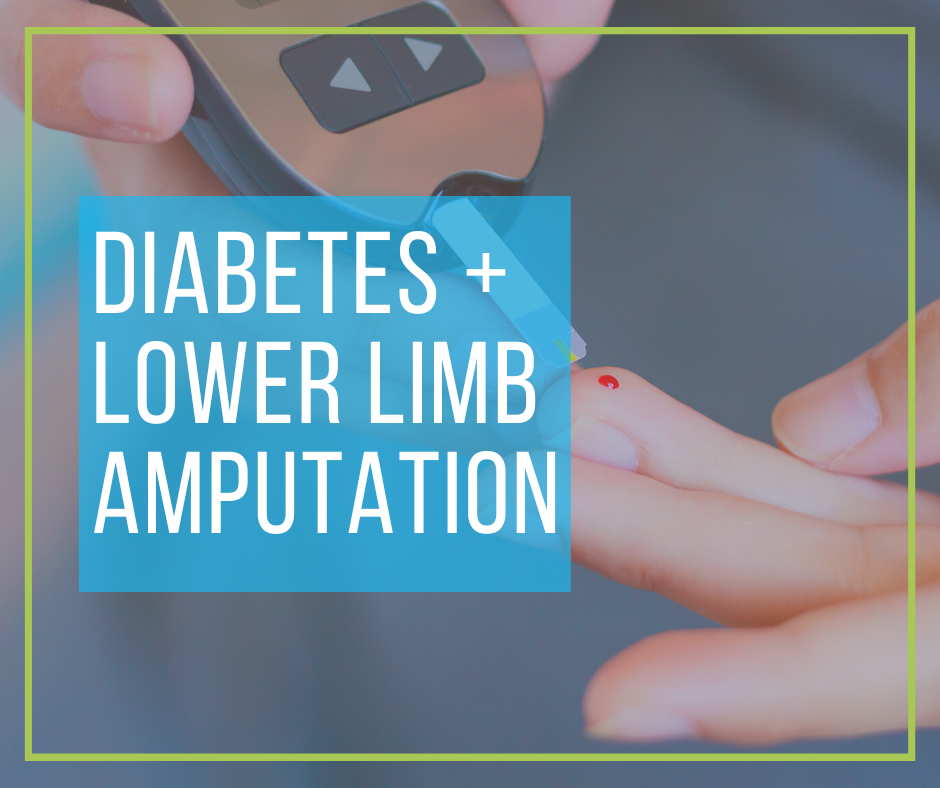
Lower Limb Amputation + Diabetes

Diabetes is a chronic condition that impacts multiple organ systems, including the renal system, peripheral nervous system and vascular system. Over time, complications from diabetes can lead to leg, ankle and foot problems that place diabetics at a higher risk of needing a lower limb amputation.
According to the American Journal of Managed Care, approximately 200,000 non-traumatic amputations occur in the United States each year1.
In a study from 2008, vascular disease, including diabetes and PAD, was the cause of amputation in 54% of Americans living with limb loss in the United States2.
In the majority of cases, a diabetic foot ulcer is the initial event that leads to lower limb amputation in people with diabetes3.
If you’re a diabetic who is at risk of lower limb amputation, here’s what you should know.
How Does Diabetes Increase the Risk of Lower Limb Amputation?
Diabetes can cause serious complications with the peripheral nervous system and vascular system.
Chronic high blood sugar can cause fats and other substances to build up on the walls of the blood vessels, causing them to narrow. This condition is known as atherosclerosis.
Over time, atherosclerosis
can progress to Peripheral Artery Disease (PAD), a condition that causes poor circulation in the extremities, especially the legs and feet.
PAD that isn’t carefully managed can cause extremely slow healing in the feet and legs. Over time, blood flow may become so compromised that even small wounds on the legs, ankles and feet don’t heal at all.
Diabetics are also at high risk of developing
nerve damage in the extremities. This condition is known as peripheral neuropathy, and it can cause numbness, tingling and loss of sensation in the legs and feet.
What is the Most Common Cause of Lower Limb Amputation Among Diabetics?
The most common cause of lower limb amputations in diabetics is lower limb ulcers, particularly foot ulcers.
Non-healing wounds on diabetics can begin as small nicks, scrapes or cuts, typically on the feet or lower legs. Poor circulation caused by PAD impedes the healing process in the lower limbs because the blood vessels cannot effectively deliver nutrients to the damaged tissue. Open wounds that aren't healing properly can easily become infected, causing potentially life-threatening side effects.
An infected ulcer on the foot or lower leg can cause infection in surrounding tissues and can spread to the bones. Oftentimes, the only way to treat the infection is to amputate the affected area.
Can Other Complications of Diabetes Lead to Lower Limb Amputation?
Peripheral neuropathy, a condition that causes nerve damage in the extremities, is a common side effect of diabetes. In fact, up to 50% of diabetics may experience some form of diabetic neuropathy. Like PAD, peripheral neuropathy increases a diabetic’s risk of amputation.
Symptoms of peripheral neuropathy can range from numbness and tingling in the lower limbs to issues with the blood vessels, digestive tract and urinary tract.
Nerve damage caused by PN makes it difficult for diabetic people to know when they have sustained an injury on the lower limbs, especially injuries that aren’t easy to see. Cuts and nicks on the bottoms of the feet, backs of the ankles and other hard-to-see areas may not produce a strong pain response, so they often go unnoticed until they have developed into open sores (diabetic ulcers).
When peripheral neuropathy is accompanied by poor circulation or PAD, wounds on the legs and feet won’t heal normally. Over time, they may become infected or gangrenous. Many times, the only option for removing the infection of gangrene is to amputate the lower leg, foot or toe.
How Can Diabetics Lower Their Risk of Lower Limb Amputation?
It is vital for all diabetics to follow their doctors’ recommendations for managing their diabetes and its side effects.
The most important way to prevent complications of diabetes is control blood sugar levels through medication, diet and monitoring your blood sugar daily.
If you have diabetes, your doctor may also recommend that you make adjustments to your lifestyle, like altering your exercise regimen, quitting smoking and drinking less.
It is extremely important for diabetics with PAD and nerve damage to check their feet, ankles and lower legs daily. This includes paying special attention to the bottoms of the feet, between the toes, the backs of the ankles and the backs of the legs for any cuts or sores that are forming.
If you get a cut or nick on your leg or foot, you should carefully follow protocols for
diabetic wound care given to you by your doctor.
Advice for Diabetics Facing Lower Limb Amputation
If you’re facing a lower limb amputation due to diabetes, it’s important to be prepared for the challenges and changes ahead.
Recovery and rehabilitation following a lower limb amputation is important for all patients, especially those with co-existing diseases that require management. For diabetics, it’s important to practice careful wound care following an amputation, as vascular issues may contribute to slow healing. As you recover from your amputation, it’s important to
It’s also vital for lower limbs amputees to find a trusted prosthetic partner that can provide resources and support throughout the amputation process.
If you’re a diabetic facing lower limb amputation in San Antonio, Houston, or anywhere in South Texas, AOD Prosthetics and Orthotics offers a complete range of amputee support. This includes pre-amputation evaluation and advanced fitting for your prosthetic device.
Contact our team today to learn more about our support and services for lower limb amputees.
Treatment & Planning for Tomorrow
AOD Prosthetics & Orthotics combines the highest technology available with the best patient care. Bilingual mobile prosthetic service in San Antonio. Serving amputees and improving their quality of life.

All Rights Reserved | AOD Prosthetics & Orthotics | San Antonio, TX


